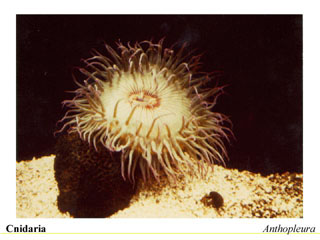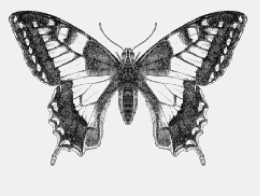
The key kinds of symmetry relevant in the study of organismal biology are radial and bilateral symmetry. In studying the evolutionary development of symmetry in plants and animals, one fascinating element that emerges is that symmetry is not easily broken in natural selection. Evidence of this comes primarily from genetic tests conducted with the fruit fly (Drosophila). For more specific information about these experiments, click here. Some scientists believe that the recorded prevalence of bilateral symmetry in organisms is simply a default result of the fact that most cells do not possess any "symmetry breaking" information. Consequently, the study of asymmet ry in organisms is intriguing, but it is a field of study that is relatively hazy due to the lack of information on cellular differentiation or coordinates of differentiation. Two examples of asymmetrical development in animals are revealed in the lobster claw, which is randomly asymmetrical, and in the coiling pattern of snails, which possess fixed asymmetry. The sponge, which is a fascinating organism in just about every aspect, actually possesses no symmetry at all and no formulaic pattern of asymmetry. For more detailed information, a very technical essay entitled, "From symmetry to asymmetry: Phylogenetic patterns of asymmetry variation in a nimals and their evolutionary significance," is available from the Biology department of the University of Alberta.
Difference in structural symmetry is one of the guiding elements behind animal diversification and the vertebrate/invertebrate split during an animal's evolutionary history. In tracing the history of biological diversity, biologists have now almost unive rsally agreed on the fact that the animal kingdom is monophyletic, meaning that if one could trace the entire evolutionary tree of animals all the way back to the Precambrian era, all of the branches would converge on one single protistan ancestor.
From that single ancestor, one of the earliest branching points in the hypothetical phylogeny of animals is the place at which multicellular beings with true tissues (eumetazoa) split into those possessing radial symmetry and those possessing bilateral sy mmetry.

Radial Symmetry: A radial animal has a top and a bottom (or an oral and aboral side), but has no head end or rear end and no left or right. Examples of animals possessing radial symmetry are: jellyfishes, corals, anemones, and ctenophora.

Bilateral Symmetry: Bilateral (two-sided) symmetry is the most common form of symmetry possible, and it is found throughout the biological and non-biological world. Animals possessing bilateral symmetry have a dorsal (top) side, a ventral (bottom ) side, an anterior (head) end, a posterior (tail) end, and a distinct left and right side. Associated with bilateral symmetry is the phenomenon of cephalization, which is the evolutionary trend towards the concentration of sensory equipment on the anter ior end; this means that such organisms are directionally sensitive and mobile. Generally the anterior, or cephalized, end is the first to encounter food, danger, or other stimuli. Before bipedal development (common in humans and apes), cephalization wa s an adaptation for movement such as crawling, burrowing, or swimming. Examples of animals that possess bilateral symmetry are: flatworms, common worms ("ribbon worms"), clams, snails, octopuses, crustaceans, insects, spiders, brachiopods, sea stars, sea urchins, and vertebrates.
The symmetry of an animal generally fits its lifestyle. For example, many radial animals are sessile forms or plankton and their symmetry equips them to meet their environment equally well from all sides. More active animals are generally bilateral. Th e two forms of symmetry, however, are not absolutely separate. A great deal of radial symmetry is proven to emerge secondarily from a bilateral condition (frequently it emerges from animals adapting to a more sedentary lifestyle). Some animals, such as t he sea urchin, are radially symmetrical, but their embryonic development and internal anatomy show that they arose from a bilaterally symmetrical ancestor.
Images of symmetry in the animal kingdom (according to phyla>:
Bilateral and radial symmetry are also found in the Plant kingdom; symmetry in ggeneral, however, is less significant here that among animals. These forms of symmetry have the most significance in the structure of flowers, which are the points of fertili zation for angiosperms. Unlike the animal kingdom in which organisms with radial symmetry developed out of a nascent bilateral structure, the opposite is true for plants. Many plant phyla have gradually evolved from having radial symmetry to having bila teral symmetry. Much of this is a result of form following function: plants possessing bilateral symmetry are capable of signaling a particular pollinator in the direction of the flowers fertilizing organs. A good way to judge floral symmetry is to plac e flowers in the following categories: 1) fused petals - radial symmetry, 2) free petals, fully open, most often radial symmetry, 3) free petals, closed, most often bilateral.
Symmetry is a pivotal concept in many other areas of biology, particularly in the study of molecular biology. Molecular biology is ultimately more complex than organismal biology, but if you want to learn more, here are some excellent links to molecular biology pages regarding symmetry:
Interactive Macromolecular Graphics - Play with the symmetry of molecular structure!For a comprehensive list of links to articles and analyses about macromolecular symmetry (primarily proteins) click here.
For an interesting article on dihedral symmetry in cancer cells (warning, this is very technical), go here.
For a great article on the symmetry of the largest macromolecule ever discovered, go here.
For everything you could ever want to know about molecular and structural biology, visit the Nature Magazine Structural Biology site. You will have to logon with a user name, but it's free and seems
to have no strings attached.
Page author: Kirsten Lodal